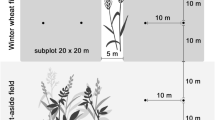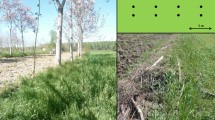Abstract
Arable weeds in organically managed fields may foster arthropod generalist predators by the provision of shelter and favorable microclimate (structure-mediated effects) and the provision of additional animal and floral food resources (resource-mediated effects). In three organically managed winter wheat fields in Central Germany, we investigated the impact of weed removal and introduction of artificial weed-like structure on the activity density and species richness of carabid beetles with respect to trophic groups, microclimatic conditions, and densities of potential prey. Removal of weeds reduced both carabid activity density and species richness but did not affect trophic group composition. The decline in carabid activity density was dampened by the addition of artificial structure. Mean daily surface temperature and light intensity were significantly lower under weeds and artificial plants than under wheat plants alone. Weed removal reduced the abundance of leafhoppers and true bugs, but the response was inconsistent across fields. We conclude that the presence of arable weeds in organically managed wheat fields fosters carabid activity density and species richness via resource-mediated effects, such as a higher availability of weed-borne resources (e.g. seeds and pollen) and herbivorous prey. Structure-mediated effects (altering the microclimate) add to this positive effect. The presence of weeds in organically managed wheat fields enhances carabid activity density and diversity and needs to be integrated into future management strategies for natural enemy conservation.


Similar content being viewed by others
References
Anderson MJ (2001) A new method for non-parametric multivariate analysis of variance. Austral Ecol 26:32–46
Anderson MJ, Gorley RN, Clarke KR (2008) PERMANOVA+ for Primer: guide to software and statistical methods. PRIMER-E Ltd, Plymouth, UK
Armstrong G, McKinlay RG (1997) The effect of undersowing cabbages with clover on the activity of carabid beetles. Biol Agric Hortic 15:269–277
Asteraki EJ, Hart BJ, Ings TC, Manley WJ (2004) Factors influencing the plant and invertebrate diversity of arable field margins. Agric Ecosyst Environ 102:219–231
Balfour RA, Rypstra AL (1998) The influence of habitat structure on spider density in a no-till soybean agroecosystem. J Arachnol 26:221–226
Bengtsson J, Ahnstrom J, Weibull AC (2005) The effects of organic agriculture on biodiversity and abundance: a meta-analysis. J Appl Ecol 42:261–269
Birkhofer K, Wise DH, Scheu S (2008) Subsidy from the detrital food web, but not microhabitat complexity, affects the role of generalist predators in an aboveground herbivore food web. Oikos 117:494–500
Booij C, Noorlander J (1992) Farming systems and insect predators. Agric Ecosyst Environ 40:125–135
Bray J, Curtis J (1957) An ordination of the upland forest communities of southern Wisconsin. Ecol Monogr 27:325–349
Brook AJ, Woodcock BA, Sinka M, Vanbergen AJ (2008) Experimental verification of suction sampler capture efficiency in grasslands of differing vegetation height and structure. J Appl Ecol 45:1357–1363
Clarke KR, Gorley RN (2006) Primer v6: user manual/tutorial. Primer-E Ltd, Plymouth, UK
Denno RF, Roderick GK (1991) Influence of patch size, vegetation texture, and host plant architecture on the diversity, abundance, and life history styles of sap-feeding herbivores. In: Bell S, McCoy E, Mushinsky H (eds) Habitat structure: the physical arrangements of objects in space. Chapman and Hall, London, pp 169–196
Ekschmitt K, Wolters V, Weber M (1997) Spiders, Carabids, and Staphylinids: the ecological potential of predatory macroarthropods. In: Benckiser G (ed) Fauna in soil ecosystems: recycling processes nutrient fluxes and agricultural production. Marcel Dekker Inc, New York, Basel, Hong Kong, pp 307–362
Freude H, Harde K, Lohse G, Klausnitzer B (2004) Die Käfer Mitteleuropas: Bd.2. Spektrum. Akademischer Verlag, Heidelberg, Berlin
Gabriel D, Roschewitz I, Tscharntke T, Thies C (2006) Beta diversity at different spatial scales: plant communities in organic and conventional agriculture. Ecol Appl 16:2011–2021
Holland J et al (2002) The agroecology of Carabid beetles. Intercept Ltd., Andover, Hampshire, UK
Honek A (1997) The effect of plant cover and weather on the activity density of ground surface arthropods in a fallow field. Biol Agric Hortic 15:203–210
Honek A, Jarosik V (2000) The role of crop density, seed and aphid presence in diversification of field communities of Carabidae (Coleoptera). Eur J Entomol 97:517–525
Honek A, Martinkova Z, Jarosik V (2003) Ground beetles (Carabidae) as seed predators. Eur J Entomol 100:531–544
Honek A, Martinkova Z, Saska P, Pekar S (2007) Size and taxonomic constraints determine the seed preferences of Carabidae (Coleoptera). Basic Appl Ecol 8:343–353
Hough-Goldstein JA, Vangessel MJ, Wilson AP (2004) Manipulation of weed communities to enhance ground-dwelling arthropod populations in herbicide-resistant field corn. Environ Entomol 33:577–586
Huk T, Kühne B (1999) Substrate selection by Carabus clatratus (Coleoptera, Carabidae) and its consequences for offspring development. Oecologia 121:348–354
Janssen A, Sabelis MW, Magalhaes S, Montserrat M, Van der Hammen T (2007) Habitat structure affects intraguild predation. Ecology 88:2713–2719
Koch K (1989) Die Käfer Mitteleuopas: Ökologie, Bd.1. Goecke & Evers Verlag, Krefeld
Langellotto GA, Denno RF (2004) Responses of invertebrate natural enemies to complex-structured habitats: a meta-analytical synthesis. Oecologia 139:1–10
Lawton JH (1983) Plant architecture and the diversity of phytophagous insects. Annu Rev Entomol 28:23–39
Lindroth C (1985/86) The Carabidae (Coleoptera) of Fennoscandia and Denmark. Scandinavian Science Press Ltd., Leiden, Copenhagen
Lövei GL, Sunderland KD (1996) Ecology and behavior of ground beetles (Coleoptera: Carabidae). Annu Rev Entomol 41:231–256
Luff M (1998) Provisional atlas of ground beetles (Coleoptera, Carabidae) of Britain. Biological Records Centre, Hunington
Marggi W (1992) Faunistik der Sandlaufkäfer und Laufkäfer der Schweiz (Cicindelidae & Carabidae), Coleoptera: Teil 1. Centre suisse de cartographie de la faune (CSCF), Neuchâtel
Marshall EJP, Brown VK, Boatman ND, Lutman PJW, Squire GR, Ward LK (2003) The role of weeds in supporting biological diversity within crop fields. Weed Res 43:77–89
Mathews CR, Bottrell DG, Brown MW (2004) Habitat manipulation of the apple orchard floor to increase ground-dwelling predators and predation of Cydia pomonella (L.) (Lepidoptera: Tortricidae). Biol Control 30:265–273
McArdle BH, Anderson MJ (2001) Fitting multivariate models to community data: a comment on distance-based redundancy analysis. Ecology 82:290–297
McCoy E, Bell S (1991) Habitat structure: the evolution and diversification of a complex topic. Chapman and Hall, London
Meiners T, Obermaier E (2004) Hide and seek on two spatial scales: vegetation structure effects herbivore oviposition and egg parasitism. Basic Appl Ecol 5:87–94
Mundy CA, Allen-Williams LJ, Underwood N, Warrington S (2000) Prey selection and foraging behaviour by Pterostichus cupreus L. (Col., Carabidae) under laboratory conditions. J Appl Entomol 124:349–358
Norris RF, Kogan M (2000) Interactions between weeds, arthropod pests, and their natural enemies in managed ecosystems. Weed Sci 48:94–158
Östman O, Ekbom B, Bengtsson J (2003) Yield increase attributable to aphid predation by ground-living polyphagous natural enemies in spring barley in Sweden. Ecol Econ 45:149–158
Pavuk DM, Purrington FF, Williams CE, Stinner BR (1997) Ground beetle (Coleoptera: Carabidae) activity density and community composition in vegetationally diverse corn agroecosystems. Am Midl Nat 138:14–28
Pflug A, Wolters V (2001) Influence of drought and litter age on Collembola communities. Eur J Soil Biol 37:305–308
Purtauf T, Dauber J, Wolters V (2005) The response of carabids to landscape simplification differs between trophic groups. Oecologia 142:458–464
Ribera I, Foster G, Downie I, McCracken D, Abernethy V (1999) A comparative study of the morphology and life traits of Scottish ground beetles (Coleroptera, Carabidea). Ann Zool Fennici 36:21–37
Ribera I, Dolédec S, Downie I, Foster G (2001) Effect of land disturbance and stress on species traits of ground beetle assemblages. Ecology 82:1112–1129
Sasakawa K (2010) Field observations of climbing behavior and seed predation by adult ground beetles (Coleoptera: Carabidae) in a lowland area of the temperate zone. Environ Entomol 39:1554–1560
Scheu S (2001) Plants and generalist predators as links between the below-ground and above-ground system. Basic Appl Ecol 2:3–13
Shearin AF, Reberg-Horton SC, Gallandt ER (2007) Direct effects of tillage on the activity density of ground beetle (Coleoptera: Carabidae) weed seed predators. Environ Entomol 36:1140–1146
Showler AT, Greenberg SM (2003) Effects of weeds on selected arthropod herbivore and natural enemy populations, and on cotton growth and yield. Environ Entomol 32:39–50
Stoate C, Boatman ND, Borralho RJ, Carvalho CR, de Snoo GR, Eden P (2001) Ecological impacts of arable intensification in Europe. J Environ Manage 63:337–365
Straub CS, Finke DL, Snyder WE (2008) Are the conservation of natural enemy biodiversity and biological control compatible goals? Biol Control 45:225–237
Symondson WOC, Glen DM, Erickson ML, Liddell JE, Langdon CJ (2000) Do earthworms help to sustain the slug predator Pterostichus melanarius (Coleoptera: Carabidae) within crops? Investigations using monoclonal antibodies. Mol Ecol 9:1279–1292
Toft S, Bilde T (2002) Carabid diets and food value. In: Holland JM (ed) The agroecology of Carabid beetles. Intercept Ltd, Andover, Hampshire
Trefas H, van Lenteren JC (2008) Egg- laying- site preferences of Pterostichus melanarius in mono- and intercrops. B Insect 61:225–231
VDLUFA (Verband Deutscher Landwirtschaftlicher Untersuchungs- und Forschungsanstalten) (1991) Die Untersuchung von Böden. VDLUFA-Verlag, Darmstadt
Woodcock BA, Potts SG, Westbury DB, Ramsay AJ, Lambert M, Harris SJ, Brown VK (2007) The importance of sward architectural complexity in structuring predatory and phytophagous invertebrate assemblages. Ecol Entomol 32:302–311
Yardim EN, Edwards CA (2002) Effects of weed control practices on surface-dwelling arthropod predators in tomato agroecosystems. Phytoparasitica 30:379–386
Zehnder G, Gurr GM, Kuhne S, Wade MR, Wratten SD, Wyss E (2007) Arthropod pest management in organic crops. Annu Rev Entomol 52:57–80
Zimdahl RL (2004) Weed-crop competition, 2nd edn. Blackwell Publishing, Iowa (USA), Oxford (UK), Victoria (Australia)
Acknowledgments
We thank two anonymous referees for their helpful comments on an earlier version of this manuscript. We are very grateful to the farmers, the Mager family, for permitting us to conduct our experiments on their fields. Thanks are due to Sascha Behr, Sergej Sereda, Janine Groh, and Kerstin Birkhofer for their assistance with the fieldwork, Sabine Wamser and Dennis Baulechner for assistance with sample determination, and Chistine Tandler, Susanne Vesper, Sabine Rauch, and Martin Kröckel for technical support. This study was carried out within the BIOPLEX project (BIOLOG Europe) funded by the German Federal Ministry of Education and Research (BMBF).
Author information
Authors and Affiliations
Corresponding author
Additional information
Handling editor: Robert Glinwood.
Electronic supplementary material
Below is the link to the electronic supplementary material.
Rights and permissions
About this article
Cite this article
Diehl, E., Wolters, V. & Birkhofer, K. Arable weeds in organically managed wheat fields foster carabid beetles by resource- and structure-mediated effects. Arthropod-Plant Interactions 6, 75–82 (2012). https://doi.org/10.1007/s11829-011-9153-4
Received:
Accepted:
Published:
Issue Date:
DOI: https://doi.org/10.1007/s11829-011-9153-4




